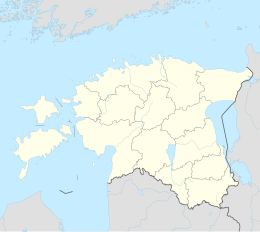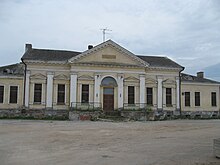Jõhvi (Jõhvi)
| Jõhvi (Jõhvi) | |||
|
|||
| State : |
|
||
| Circle : |
|
||
| Founded : | 1938 (first city rights) | ||
| Coordinates : | 59 ° 21 ′ N , 27 ° 25 ′ E | ||
| Area : | 7.62 km² | ||
| Residents : | 10,662 (January 1, 2014) | ||
| Population density : | 1,399 inhabitants per km² | ||
| Time zone : | EET (UTC + 2) | ||
| Telephone code : | (+372) 336 | ||
| Postal code : | 41501-41599 | ||
| Community type: | city | ||
| Mayor : | Max Kaur | ||
| Postal address : | Keskväljak 4 41595 Jõhvi |
||
| Website : | |||
|
|
|||
Jõhvi (German Jewe , Russian Йыхви) is a city in northeast Estonia . It is the capital of Ida-Viru County .
Location and population
Jõhvi is located 42 kilometers southwest of the third largest Estonian city Narva . The area is 7.62 km².
Since 2005, the city has been part of the rural municipality of Jõhvi ( Jõhvi vald ). The municipal administration has its seat in the city. The administration building was built in 1954.
Jõhvi is on the railway line from Tallinn via Narva to Saint Petersburg . The major highways Tallinn-Narva-Saint Petersburg and Riga - Tartu -Jõhvi meet in Jõhvi. The Pühajõgi River flows through the urban area .
To the west and south of the city are the mining areas for oil shale , which shaped the city industrially during the existence of the Estonian SSR . In Jõhvi, as in the other industrial cities of northeast Estonia, the Soviet authorities have settled numerous Slavic-speaking workers from other parts of the Soviet Union. The Estonians became a minority after the Second World War.
In 1938 there were 2,525 people in Jõhvi. After the destruction of the Second World War, the city only had 800 inhabitants. With Soviet industrialization, the population grew rapidly: in 1959, over ten thousand people lived in the city. Shortly after the collapse of the Soviet Union, Jõhvi had 16,400 inhabitants. Today the number has dropped to just under 10,500. Because of unemployment, the demographic development is negative.
Today over fifty percent of the city's population are ethnic Russians . Estonians only make up about a third of the population. Other ethnic groups are Ukrainians and Belarusians.
The city's living space is characterized by four-storey type buildings, such as those built all over the Soviet Union. In the quarter south of the railway line, five- to nine-story type buildings shape the cityscape.
history
Before the conquest and Christianization of Estonia there was probably a fortress of the pagan Estonians on the site. The Low German name Jõhvi first appeared as Gewi 1241 in the Waldemar- Erdbuch ( Liber Census Daniæ ), a Danish tax register. Its etymology has not yet been finally clarified.
Cistercians had founded the first church. The parish of Jõhvi was established around 1250 . After the destruction of the first church in battles between Russians and Germans in 1367, a stone fortress church was built, which was part of a fortress belt between Lake Peipus and the Gulf of Finland . It also included the vassal castles of Edise and Järve . 1491 mentioned church sources for the first time Ordensgut Jõhvi ( Jeweled ).
In the 16th century, during the Livonian War, fierce fighting took place in the parish of Jõhvi. After conquering the fortress church on February 3, 1558, the victors robbed the church and eventually burned it down. The parish was devastated. In 1581, Swedish troops captured Jõhvi and introduced the Swedish administrative system. So the fief Jõhvi was created on the basis of the Jõhvi monastery, which coincided territorially with the parish of Jõhvi.
The year 1782 was important for the development of the city, when the post route from Tallinn to the Russian capital Saint Petersburg no longer led on the Baltic coast, but through Jõhvi. The important connection route from Saint Petersburg to Western Europe via the Livonian cities of Tartu and Riga also passed through Jõhvi. In 1782, the Jõhvi post office opened.
The first fair took place in Jõhvi in 1825 and the first shops opened. Pastor FF Meyer founded a church school in 1852, ten years later it became a school for the parish, which existed until 1883. In 1865 a song festival was held in Jõhvi parish .
Jõhvi received a great boost when the railway line between the Estonian capital Tallinn and the Russian capital Saint Petersburg went into operation in 1870. In 1889 the place became the seat of court for the region.
In 1917 Jõhvi was given the rank of large village ( alevik ). In 1938 Jõhvi became a city.
During the existence of the Soviet Union , Jõhvi was incorporated into the city of Kohtla-Järve in 1960 . In 1991 Jõhvi became an independent city again. Since 2005, the city of Jõhvi has been part of the rural municipality of the same name ( Jõhvi vald ).
economy
During the Second World War , the city was largely destroyed in the fighting between the German Wehrmacht and the Red Army . 60 percent of the residential buildings fell victim to the war. In 1944, on their retreat, the German troops blew up the train station, the middle school and the beer and schnapps factory.
With the Soviet occupation of Estonia, the region began to become more industrialized. The station was rebuilt; Oil shale mine No. 2 was built in the western part of the city in 1949. It was in operation until 1973. With the creation of Soviet industrial plants, the influx of mostly Slavic-speaking citizens from other parts of the Soviet Union was associated.
In contrast to the neighboring cities of Kohtla-Järve , Sillamäe and Narva, there are no large operations in Jõhvi other than oil shale mining. This is where the administrative headquarters of Eesti Energia Kaevandused AS , a subsidiary of Eesti Põlevkivi , which mines oil shale in the region, are located. Other employers in the 21st century are companies in the food industry.
In the east of the city is currently Estonia's most modern prison (as of 2010s), the Viru Vangla .
Education and culture
There is a Russian-speaking and an Estonian-speaking high school in Jõhvi. There is a vocational school and the Tartu University branch for environmental science.
In 2005 the modern Jõhvi concert hall was completed. The design comes from the architects Ra Luhse and Tanel Tuhal. There are also two professional children's theaters and various choirs and dance ensembles.
The 41 hectare city park offers relaxation.
Churches and cemeteries
Evangelical Lutheran Church
In the west of the city is the Evangelical Lutheran Michaeliskirche ( Mihkli kirik ) with its fifteen hectare cemetery. The church, consecrated to the Archangel Michael , is the oldest building in the city. The first foundation probably goes back to the middle of the 14th century.
The single-nave church building is characterized by its irregularly shaped walls, which are up to two meters wide and indicate its former function as a fortress church. At the beginning of the 16th century, shortly before the outbreak of the Livonian War , the eight-story tower was added to the west side. The baroque tower spire dates from 1728. It got its current appearance after being destroyed several times in 1984. Since 2009 the church has had a bell again.
The pulpit made in the workshop of the Tallinn master Johann Valentin Rabe was installed in 1728. Ernst von Liphardt painted the altarpiece of the Ascension of Christ in 1900 . Numerous concerts are held in the church. The organ from 1957 comes from the Estonian workshop Kriisa.
A small museum has been set up in the basement of the church, the former powder cellar, since 2002. Archaeological artifacts from the area around the city can also be seen there, including the oldest iron finds in Estonia. There is a small chapel in the crypt next to the museum hall .
German military cemetery
Next to the church is the German military cemetery, which was prepared in August 2001 and is looked after by the Volksbund Deutsche Kriegsgräberfürsorge . About 3,000 soldiers who died on the Narva Front in the summer of 1944 were buried there.
Russian Orthodox Church
The Russian Orthodox Church of the Epiphany was built in 1894/95 in the style of historicism . A Greek cross forms the floor plan of the three-part central building . In the west is the bell tower, in the east the polygonal apse . The iconostasis dates from the 1870s.
The church is now subordinate to the Estonian Orthodox Church of the Moscow Patriarchate . The most famous clergyman of the church after the Second World War was Alexei Michailowitsch Ridiger, who from 1990 to 2002 was Alexius II. Patriarch of Moscow and all of Russia and thus the head of the Russian Orthodox Church.
Methodist Church
There is also a Methodist church in the city .
Web links
- Official website
- Entry in Eesti Entsüklopeedia (online version)
Individual evidence
- ↑ Jõhvi ajalooline ülevaade ( Memento from November 4, 2017 in the Internet Archive )
- ↑ Johvi Mihkli church and museum (Estonian) .
- ^ Salem Baptist Church in Tartu
- ↑ Indrek Rohtmets: Kultuurilooline Eestimaa. Tallinn 2004 ( ISBN 9985-3-0882-4 ), p. 189.
- ↑ Johvi Lord Baptism Church
- ↑ eestigiid.ee








